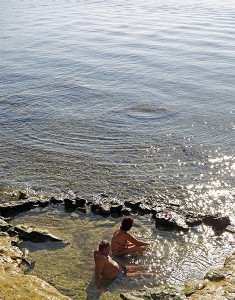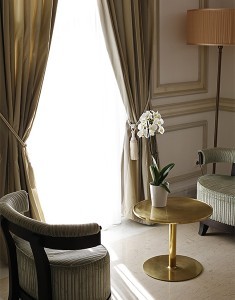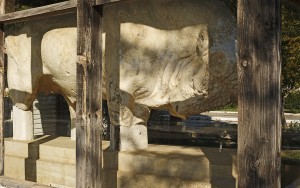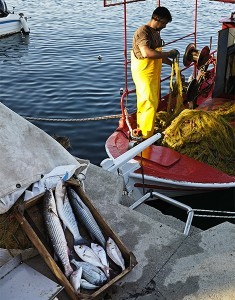Only once you see it for about the 45th time do you start to get used to it: thick steam rising skywards above frothing hot water, while all around you the rocks are all shades of red and ochre, stained and shaped by the minerals bubbling up from the depths of the earth’s crust.
The geothermal springs in Aidipsos and the surrounding area in northwestern Evia are numerous and widespread: you find them along the length of beaches, by an olive grove, beneath plane trees, in a field between two houses, near the pier in Gialtra, in the sand in Ilias. The water comes from up to 2.5 km underground at temperatures ranging between 34 – 82˚C. Springs with such large depths and high temperatures are rare. The waters are also rich in minerals: potassium, calcium, magnesium, iron, and sodium, among others.
Precisely because of their uniqueness, the hot springs in Aidipsos have played a major role in shaping the small town’s history, sometimes for the better and sometime for the worse.
The therapeutic properties of the waters have traditionally attracted chiefly elderly visitors seeking treatment for arthritis, rheumatism and other ailments. But this has meant that the potential for more contemporary wellness tourism, with the hot waters offering relaxation and rejuvenation to all ages in more modern spa-like settings has historically been ignored. Similarly the other joys of northeastern Evia – the gorgeous landscapes with dense forests reaching down to the sea, its rich history and hearty cuisine – have also been overshadowed.
The town of Aidipsos is located 4 km to the north of Loutra Aidpsou (meaning the ‘Baths of Aidispos’), towards the island’s interior. From the end of the 19th century, the population began to migrate towards the sea and the area’s thermal springs, and in 1920 the settlement of Loutra Aidipsou was officially recognized.

Built parallel to the coastline, the homes are situated amphitheatrically around the seafront. The southern part of the town is dominated by the old, large buildings housing hotels and hydrotherapy facilities, many of which today stand empty. All of the town’s life is concentrated around the coastal road.
Below are 8 reasons to put this geothermal wonder on your wellness map:
1. THE HOT AL FRESCO SHOWERS
In Loutra Aidipsou, the water that bubbles up from the ground traverses a few meters, coloring the rocks before forming a small waterfall that spills into the sea. It is hot to the point of scalding. It also offers an opportunity for you to build up your nerve and enjoy a natural skin treatment by alternating between cold and hot.
To get to the waterfall you have to wade knee-deep through the sea. If you stand directly under the waterfall for a few seconds the heat will become nearly unbearable. Move away, take a deep breath and dive into the cold sea. As soon you start to feel cold again return to the hot waterfall. Repeat as many times as you can bear. Alternating between hot and cold like this is said to help firm and tone the skin.
2. PURE RELAXATION AND WELLNESS IN THERMAE SYLLA SPA
In the indoor poor, you won’t hear a whisper, only the sound of the thermal waters emerging from the large ‘mushroom’ in the center of the pool. Bathers gather around it, positioning themselves so that the 32˚C water strikes them on their necks and upper backs. Steam clouds fill the space, rendering it almost dreamlike.
The hotel Thermae Sylla Spa has the best facilities in the area and makes optimal use of its private geothermal spring. Aside from the two pools – one indoor and one outdoor, it also offers steam baths, hydro-massage therapies, treatments with therapeutic mud and a full wellness and dietary program. The pools are emptied and cleaned every evening. The hotel’s facilities can also be used by non-guests.
3. THE CHARMING SEAFRONT AND THE “KYMA”
An afternoon walk on the coastal road in Loutra Aidipsou will reveal many a postcard-worthy scene. Set off from opposite the town hall, pass by the hot springs that spill into the sea and rows of cafés, and stop to admire the “Kyma” (meaning wave) – a key landmark and once the town’s most popular gathering spot.

Built out over the sea on pylons, the wooden octagonal building once housed a café and pastry shop. Today the Kyma has been renovated and hosts various cultural events and exhibitions. Continue on towards the harbor and the fishing boats, pass the “3 molous” (3 piers) and end your walk on Aghios Nikolaos beach. If you’ve timed it to coincide with sunset, so much the better, you will see it sink behind the peninsula of Liohada.
4. A ROAD TRIP TO LIOHADA
The peninsula of Liohada is pristine and seemingly from a different age. Keep going straight after the beach of Aghios Nikolaos and the road will take you to the village of Gialtra where you will see more hot springs flowing into the sea. The road continues following the coastline, where the scene is one of small fishing boats, rich vegetation and seemingly empty landscapes that nevertheless fill you up.
Drive as far as the beach of Kavos where you will meet fishermen and small groups of nature lovers. Across the water are the Lihadonisia (the ‘islands of Lihada), an ideal summer destination with enchanting beaches. Note: this drive is best done at an easy pace, with your favorite music on and in the company of friends who enjoy long, contemplative silences.
5. THE ARCHITECTURAL GEMS
Loutra Aidipsou is like an open air architectural exhibition. The majority of the grand buildings were built as hotels and hydrotherapy facilities. The Thermae Sylla was the first to be built in 1896. It is protected as a cultural monument and continues to operate to this day, but the majority have been abandoned.
A characteristic example is the Irakleion, constructed in 1901. The red building that housed the hydrotherapy facility is located high above the sea and enjoys stunning views. In the past it was visited by such luminaries as the famous Greek poet, Kostis Palamas who enjoyed sitting in the gazebo at sunset.
A little further on is the Stadion which was built a few years later. The abandoned building of the hotel Kastalia is equally impressive, dating to 1910.
6. A VISIT OREOI: A FISHING VILLAGE WITH HISTORY
Nearby Oreoi is a town rich in history, an important naval base both during the Roman era, and more recently during the Balkan wars. Today it is a picturesque fishing village on the northern coast of Evia about 17 km from Loutra Aidipsou and 5 km from the town of Istiaia.
Take a stroll along the pedestrian walkway that runs along the length of the seafront and see the impressive ancient Bull of Oreoi in the park opposite the Port Authority building. The 3.2 m long marble bull was discovered in 1965 on the beach and dates to the Hellenistic Period.
7. THE ENCHANTING MYTHS AND HISTORY OF LOUTRA AIDIPSOU
Loutra Aidipsou itself has a rich history that dates back to prehistoric times and there is many a myth that is associated with the area.
One explains the existence of the thermal springs: the goddess Athena asked her brother, the god of fire Hephaestus, to bring hot water so that Heracles, who she was protecting, could rest following his 12 feats. Hephastus struck the earth with a hammer and springs of hot water sprung forth that eased Heracles’ tired limbs.
Aidipsos rose in prosperity and grandeur during the Roman era, and in particular under the Roman general Sylla who would come often to bathe in the thermal springs. Behind the hydrotherapy facility operated by the National Tourism Organization (EOT), Roman era baths have survived to this day in a cave known as ‘Sylla’s cave’.
Later, as Christianity was taking hold, bathhouses were banned as places of sin. However this edict was obviously regretted, as a mere 40-50 years later on, not only was the prohibition lifted, but citizens were required to bathe at least twice a week.
There is little information regarding the Ottoman period, and then from the end of the 19th century Loutra began to flourish again with new hotels constructed to accommodate the growing numbers of visitors to the area.
8. THE INCREDIBLE FRESH FISH THAT YOU WILL FIND EVERYWHERE
The waters around the north of Evia are among the Aegean’s richest fishing grounds. Across the area you will see dozens of fishing vessels, while many an amateur fisherman also try their luck.
If you head to the harbor early in the morning you will be able to purchase freshly-caught fish and seafood. Alternatively, most of the area’s tavernas work with local fishermen and you will find fresh fish both big and small at very reasonable prices in Loutra, Oreoi, Limni and elsewhere.
Source: greece-is
Ask me anything
Explore related questions





















